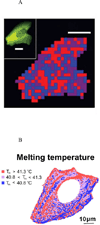Macromolecular Crowding In Vitro, In Vivo, and In Between
- PMID: 27669651
- PMCID: PMC5804487
- DOI: 10.1016/j.tibs.2016.08.013
Macromolecular Crowding In Vitro, In Vivo, and In Between
Abstract
Biochemical processes take place in heterogeneous and highly volume-occupied or crowded environments that can considerably influence the reactivity and distribution of participating macromolecules. We summarize here the thermodynamic consequences of excluded-volume and long-range nonspecific intermolecular interactions for macromolecular reactions in volume-occupied media. In addition, we summarize and compare the information content of studies of crowding in vitro and in vivo. We emphasize the importance of characterizing the behavior not only of labeled tracer macromolecules but also the composition and behavior of unlabeled macromolecules in the immediate vicinity of the tracer. Finally, we propose strategies for extending quantitative analyses of crowding in simple model systems to increasingly complex media up to and including intact cells.
Keywords: crowding theory; in-cell experiments; long-range interactions; nonspecific interactions; steric interactions.
Published by Elsevier Ltd.
Figures



References
-
- Minton AP, Wilf J. Effect of macromolecular crowding upon the structure and function of an enzyme: glyceraldehyde-3-phosphate dehydrogenase. Biochemistry. 1981;20:4821–4826. - PubMed
-
- Record MT, Jr, et al. Biophysical compensation mechanisms buffering E. coli protein-nucleic acid interactions against changing environments. Trends in Biochemical Sciences. 1998;23:190–194. - PubMed
-
- Minton AP. How can biochemical reactions within cells differ from those in test tubes? J. Cell Sci. 2006;119:2863–2869. - PubMed
Publication types
MeSH terms
Substances
Grants and funding
LinkOut - more resources
Full Text Sources
Other Literature Sources

